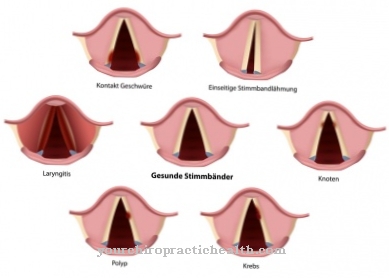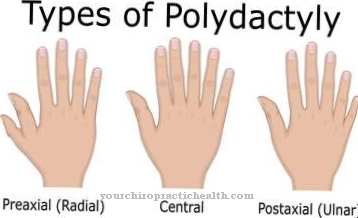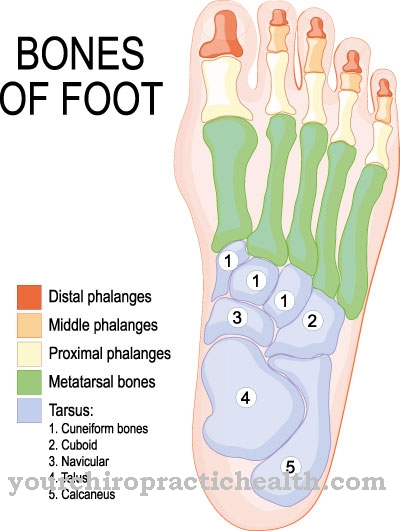The post-infectious glomerulonephritis represents an inflammatory process in the kidney corpuscles (medical term glomeruli). The cause of the disease is a reaction of the immune system to a certain type of pathogen, the so-called nephritogenic streptococci. In the majority of cases, post-infectious glomerulonephritis occurs between the ages of two and ten of the affected patient. In addition, observations indicate that men are more likely to develop post-infectious glomerulonephritis than women.
What is Post-Infectious Glomerulonephritis?

© designua - stock.adobe.com
The post-infectious glomerulonephritis sometimes will Post-streptococcal glomerulonephritis called. Basically, the kidney corpuscles are acutely inflamed as part of the disease. Post-infectious glomerulonephritis usually develops a few weeks after an infection of the organism with a special form of streptococcus.
The disease often develops in the first to fourth week after such an infection. It can be observed that post-infectious glomerulonephritis is increasingly triggered by other types of pathogens. These include, for example, various viral and bacterial pathogens, but also parasites and fungi.
The immune complexes accumulate within the capillary vessels of the kidney corpuscles, so that the organ is damaged. Because the so-called complement system is stimulated by the accumulation of the substances. As a result, various complaints appear in those suffering from post-infectious glomerulonephritis. In many cases, dark-colored urine and hematuria are characteristic symptoms.
causes
The most common cause of the development of post-infectious glomerulonephritis is usually infections with so-called nephritogenic streptococci of category A. An infection with the pathogen is possible either via the respiratory tract or the skin. As a result of the infection, the affected organism forms special antibodies.
These specialize on the one hand in the epitopes on the surface of the streptococci, but at the same time on the body's own kidney corpuscles and their structure. The antibodies produced by the immune system accumulate on the surface of the basal membranes of the kidney corpuscles. This creates bulges that can be clearly seen when examining with an electron microscope.
As a result, the organism reacts with inflammation, which is characterized by various features. Certain types of granulocytes cause the release of so-called proinflammatory cytokines. In addition, the complement system is stimulated, which creates special lysis complexes. Eventually, the basal membrane of the glomeruli is damaged.
Due to the inflammatory processes, the endothelial cells swell. In addition, the capillaries close. Post-infectious glomerulonephritis is no longer triggered only by streptococci, but in some cases also by gram-negative germs, fungi or viral germs. Even an infestation of the organism with certain parasites sometimes triggers post-infectious glomerulonephritis.
Symptoms, ailments & signs
Post-infectious glomerulonephritis manifests itself through special symptoms which, on medical examination, suggest the disease. As a rule, the typical symptoms develop about one to three weeks after the causative infection with the pathogens. People suffering from post-infectious glomerulonephritis suffer from general symptoms such as headache, fever and abdominal pain.
There is also a brownish or dark colored urine. In addition, proteinuria develops, so that what is known as periorbital edema develops as a result. In addition, many patients suffer from hypertension. The dark urine results in particular from the fact that more erythrocytes are excreted from the organism in the urine. This phenomenon is also known as hematuria.
The function of the kidneys is reduced in most cases, while the production of urine decreases. In addition, it has been shown that treatment with drugs has little effect on the disease. In the majority of cases, post-infectious glomerulonephritis is self-limiting, so that the prognosis is comparatively positive. However, various complications are possible, such as brain edema, kidney weakness and epileptic seizures.
Diagnosis & course of disease
The doctor makes the diagnosis of post-infectious glomerulonephritis primarily on the basis of the characteristic clinical symptoms of the disease. For this purpose, he takes an anamnesis with the patient in order to gain insight into the individual complaints. After talking to the person concerned, the doctor will examine the symptoms using various methods. Analyzes of the urine, which can be used to detect erythrocyte and proteinuria, play an important role here.
A so-called leukocyte cylinder can also be detected. In addition, typical phenomena such as hyponatremia and hyperkalaemia appear in the case of kidney weakness. As a rule, there are no increased concentrations of urea and creatinine. Such examinations usually allow a relatively reliable diagnosis of post-infectious glomerulonephritis.
Complications
Post-infectious glomerulonephritis is already a complication of an infectious disease. In most cases, however, the prognosis is very good. However, this also depends on whether children or the elderly are affected. In children, the symptoms usually regress quickly after an acute course. In one to ten percent of the sick children, serious complications can arise.
For unknown reasons, a flash-like course then appears, which can lead to kidney insufficiency or kidney failure, cerebral edema and seizures. In the context of renal insufficiency, the patient often needs regular dialysis or even a kidney transplant as the disease progresses. Furthermore, the occurrence of brain edema is a very serious complication.
In addition to severe headaches, nausea, vomiting and dizziness, breathing difficulties, visual disturbances, impaired consciousness and even coma and unusual hiccups are observed here. The strong increase in pressure in the brain often leads to the displacement and compression of vital brain structures. This leads to life-threatening situations.
The prognosis for post-infectious glomerulonephritis in older people is often much worse than in children. This is especially true for those who suffer from diabetes, malnutrition or alcoholism. Approximately 20 to 25 percent of all elderly patients who have had post-infectious glomerulonephritis die from heart failure, uremia, or kidney failure.
When should you go to the doctor?
Symptoms such as skin infections or water retention suggest post-infectious glomerulonephritis. A doctor's visit is indicated if the symptoms are related to a viral or bacterial infection. Then the sick have to consult a specialist who can clarify the symptoms and prescribe a suitable drug. The symptoms usually appear a week to a month after a strep infection. In some cases, post-infectious glomerulonephritis resolves on its own.
If the symptoms are only mild and decrease after four to seven days, a doctor's visit is not absolutely necessary. Children, sick and elderly people as well as pregnant women should always see a doctor with the disease. In addition to the family doctor, the internist is the right contact. If the skin is involved, a dermatologist can be consulted. If neurological symptoms arise, the help of a neurologist is necessary. In the case of severe symptoms, a nephrologist, urologist or cardiologist can also be consulted to treat the individual symptoms.
Treatment & Therapy
The treatment of post-infectious glomerulonephritis is based on the individual case. If kidney function is impaired, it is necessary to regulate the water and salt balance. For this purpose, diuretic agents and antihypertensive drugs are usually used. This reduces the risk of high blood pressure and edema. In addition, patients often receive penicillins as a preventive measure.
prevention
Preventive measures address the causes of post-infectious glomerulonephritis. The risk of infection can be reduced through hygienic standards.
Aftercare
In the case of post-infectious glomerulonephritis, follow-up care is largely outpatient and only possible to support the healing process. In the majority of cases, the disease subsides after several days, even without medical treatment. However, the body should be spared by taking measures such as bed rest, restricted fluid intake and adhering to a low-sodium and low-protein diet until complete recovery. Avoid physical exertion.
After the illness with post-infectious glomerulonephritis, a follow-up examination with the family doctor is advisable in order to determine whether the kidney function is back to normal. This is especially important in patients who have had additional complications such as edema or electrolyte imbalances in order to avoid complications.
Furthermore, in severe cases, the doctor can prescribe additional antibiotic treatment to prevent the spread of streptococci to other people. It is important here to ensure that it is taken correctly. The prognosis for post-infectious glomerulonephritis is generally positive.
Young patients usually regain full kidney function. In adults, however, the tendency is worse, so that permanent kidney damage can occur, especially in combination with other risk factors. This should be monitored and monitored over the long term.
You can do that yourself
Since post-infectious glomerulonephritis generally responds very well to medical treatment, there is usually no major restriction in everyday life to be expected.
Children in particular should be offered distraction during long hospital stays. Regular visits from family and friends are just as much a part of this as meaningful occupation. For example, friends and comrades can be brought along on the next visit. Helping with any homework, etc., also provides other thoughts and helps not to miss too much learning material.
The intake of diuretic medication means that the diaper of smaller children has to be changed much more frequently and the moist genital area must be kept dry. If the child would rather go to the toilet, help should of course also be offered here, if necessary. Great importance should be attached to good intimate hygiene.
It is also the task of the parents to comfort the little ones with fears and worries and to support them with any necessary examinations. Holding your hand alone can be sufficient and effectively reduce stress.













.jpg)

.jpg)
.jpg)











.jpg)